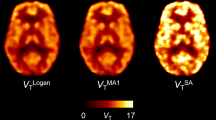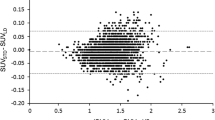Abstract
Purpose
This study was conducted to directly compare the high-resolution research tomograph (HRRT) (high-resolution brain) and HR+ (standard whole-body) positron emission tomography (PET) only scanners for quantitative brain studies using three tracers with vastly different tracer distributions.
Procedures
Healthy volunteers underwent successive scans on HR+ and HRRT scanners (in random order) using either (R)-[11C]verapamil (n = 6), [11C]raclopride (n = 7) or [11C]flumazenil (n = 7). For all tracers, metabolite-corrected plasma-input functions were generated.
Results
After resolution matching, HRRT-derived kinetic parameter values correlated well with those of HR+ for all tracers (intraclass correlation coefficients ≥0.78), having a good absolute interscanner test-retest variability (≤15 %). However, systematic differences can be seen for HRRT-derived kinetic parameter values (range −13 to +15 %).
Conclusion
Quantification of kinetic parameters based on plasma-input models leads to comparable results when spatial resolution between HRRT and HR+ data is matched. When using reference-tissue models, differences remain that are likely caused by differences in attenuation and scatter corrections and/or image reconstruction.






Similar content being viewed by others
References
de Jong HW, van Velden FH, Kloet RW et al (2007) Performance evaluation of the ECAT HRRT: an LSO-LYSO double layer high resolution, high sensitivity scanner. Phys Med Biol 52:1505–1526
Alakurtti K, Aalto S, Johansson JJ et al (2011) Reproducibility of striatal and thalamic dopamine D2 receptor binding using [11C]raclopride with high-resolution positron emission tomography. J Cereb Blood Flow Metab 31:155–165
Heiss WD, Habedank B, Klein JC et al (2004) Metabolic rates in small brain nuclei determined by high-resolution PET. J Nucl Med 45:1811–1815
Leroy C, Comtat C, Trebossen R et al (2007) Assessment of 11C-PE2I binding to the neuronal dopamine transporter in humans with the high-spatial-resolution PET scanner HRRT. J Nucl Med 48:538–546
van Velden FH, Kloet RW, van Berckel BN et al (2009) HRRT versus HR+ human brain PET studies: an interscanner test-retest study. J Nucl Med 50:693–702
Brix G, Zaers J, Adam LE et al (1997) Performance evaluation of a whole-body PET scanner using the NEMA protocol. National Electrical Manufacturers Association. J Nucl Med 38:1614–1623
Adam LE, Zaers J, Ostertag H et al (1997) Performance evaluation of the whole-body PET scanner ECAT EXACT HR+ following the IEC standard. IEEE Trans Nucl Sci 44:1172–1179
van Velden FHP, Kloet RW, de Jong HWAM et al (2006) Quantitative experimental comparison of HRRT versus HR+ PET brain studies. IEEE Nuclear Science Symposium Conference Record (NSS/MIC) 5: 3097–3099
van Velden FH, Kloet RW, van Berckel BN et al (2009) Accuracy of 3-dimensional reconstruction algorithms for the high-resolution research tomograph. J Nucl Med 50:72–80
van Velden FH, Kloet RW, van Berckel BN et al (2008) Impact of attenuation correction strategies on the quantification of high resolution research tomograph PET studies. Phys Med Biol 53:99–118
Son YD, Kim HK, Kim ST et al (2010) Analysis of biased PET images caused by inaccurate attenuation coefficients. J Nucl Med 51:753–760
Sibomana M, Keller SH, Stute S, Comtat C (2012) Benefits of 3D scatter correction for the HRRT—a large axial FOV PET scanner. IEEE Nuclear Science Symposium and Medical Imaging Conference (NSS/MIC) 2954–2957
Keller SH, Svarer C, Sibomana M (2013) Attenuation correction for the HRRT PET-scanner using transmission scatter correction and total variation regularization. IEEE Trans Med Imaging 32:1611–1621
Walker MD, Asselin MC, Julyan PJ et al (2011) Bias in iterative reconstruction of low-statistics PET data: benefits of a resolution model. Phys Med Biol 56:931–949
Laruelle M (2000) Imaging synaptic neurotransmission with in vivo binding competition techniques: a critical review. J Cereb Blood Flow Metab 20:423–451
Boellaard R, van Lingen A, Lammertsma AA (2001) Experimental and clinical evaluation of iterative reconstruction (OSEM) in dynamic PET: quantitative characteristics and effects on kinetic modeling. J Nucl Med 42:808–817
Boellaard R, van Lingen A, van Balen SC et al (2001) Characteristics of a new fully programmable blood sampling device for monitoring blood radioactivity during PET. Eur J Nucl Med 28:81–89
Sureau FC, Reader AJ, Comtat C et al (2008) Impact of image-space resolution modeling for studies with the high-resolution research tomograph. J Nucl Med 49:1000–1008
Olesen OV, Sibomana M, Keller SH et al (2009) Spatial resolution of the HRRT PET scanner using 3D-OSEM PSF reconstruction. IEEE Nuclear Science Symposium Conference Record (NSS/MIC) 3789–3790
Anton-Rodriguez JM, Sibomana M, Walker MD et al (2010) Investigation of motion induced errors in scatter correction for the HRRT brain scanner. IEEE Nuclear Science Symposium Conference Record (NSS/MIC) 2010: 2935–2940
Cizek J, Herholz K, Vollmar S et al (2004) Fast and robust registration of PET and MR images of human brain. Neuroimage 22:434–442
van Assema DM, Lubberink M, Boellaard R et al (2012) Reproducibility of quantitative (R)-[11C]verapamil studies. EJNMMI Res 2:1
Schuit RC, Luurtsema G, Greuter HN et al (2007) Intravenous amphetamine administration does not affect metabolism of [11C]raclopride. J Label Compd Radiopharm 50:S471
Liefaard LC, Ploeger BA, Molthoff CF et al (2009) Changes in GABAA receptor properties in amygdala kindled animals: in vivo studies using [11C]flumazenil and positron emission tomography. Epilepsia 50:88–98
Svarer C, Madsen K, Hasselbalch SG et al (2005) MR-based automatic delineation of volumes of interest in human brain PET images using probability maps. Neuroimage 24:969–979
Hammers A, Koepp MJ, Free SL et al (2002) Implementation and application of a brain template for multiple volumes of interest. Hum Brain Mapp 15:165–174
Lubberink M, Luurtsema G, van Berckel BN et al (2007) Evaluation of tracer kinetic models for quantification of P-glycoprotein function using (R)-[11C]verapamil and PET. J Cereb Blood Flow Metab 27:424–433
Klumpers UM, Veltman DJ, Boellaard R et al (2008) Comparison of plasma input and reference tissue models for analysing [(11)C]flumazenil studies. J Cereb Blood Flow Metab 28:579–587
Lammertsma AA, Bench CJ, Hume SP et al (1996) Comparison of methods for analysis of clinical [11C]raclopride studies. J Cereb Blood Flow Metab 16:42–52
Lammertsma AA, Hume SP (1996) Simplified reference tissue model for PET receptor studies. Neuroimage 4:153–158
Innis RB, Cunningham VJ, Delforge J et al (2007) Consensus nomenclature for in vivo imaging of reversibly binding radioligands. J Cereb Blood Flow Metab 27:1533–1539
Chow TW, Mamo DC, Uchida H et al (2009) Test-retest variability of high resolution positron emission tomography (PET) imaging of cortical serotonin (5HT2A) receptors in older, healthy adults. BMC Med Imaging 9:12
Leroy C, Karila L, Martinot JL et al (2012) Striatal and extrastriatal dopamine transporter in cannabis and tobacco addiction: a high-resolution PET study. Addict Biol 17:981–990
Madsen K, Hasselbalch BJ, Frederiksen KS et al (2012) Lack of association between prior depressive episodes and cerebral [(11)C]PiB binding. Neurobiol Aging 33:2334–2342
Varrone A, Sjoholm N, Eriksson L et al (2009) Advancement in PET quantification using 3D-OP-OSEM point spread function reconstruction with the HRRT. Eur J Nucl Med Mol Imaging 36:1639–1650
Mourik JE, Lubberink M, van Velden FH et al (2010) In vivo validation of reconstruction-based resolution recovery for human brain studies. J Cereb Blood Flow Metab 30:381–389
Kloet RW, de Jong HW, van Velden FH et al (2006) Influence of outside field of view activity on the quality of high resolution research tomograph (HRRT) brain studies. IEEE Nuclear Science Symposium and Medical Imaging Conference (NSS/MIC) 3369–3371
Verhaeghe J, Reader AJ (2010) AB-OSEM reconstruction for improved Patlak kinetic parameter estimation: a simulation study. Phys Med Biol 55:6739–6757
Nuyts J, Stroobants S, Dupont P et al (2002) Reducing loss of image quality because of the attenuation artifact in uncorrected PET whole-body images. J Nucl Med 43:1054–1062
Polycarpou I, Thielemans K, Manjeshwar R et al (2011) Comparative evaluation of scatter correction in 3D PET using different scatter-level approximations. Ann Nucl Med 25:643–649
van Velden FH, Kloet RW, van Berckel BN et al (2008) Comparison of 3D-OP-OSEM and 3D-FBP reconstruction algorithms for high-resolution research tomograph studies: effects of randoms estimation methods. Phys Med Biol 53:3217–3230
Andersen FL, Ladefoged CN, Beyer T et al (2014) Combined PET/MR imaging in neurology: MR-based attenuation correction implies a strong spatial bias when ignoring bone. Neuroimage 84:206–216
Acknowledgments
This work was financially supported by the EU seventh framework programme EURIPIDES (FP7/2007-2013 under grant agreement no. 201380) and the Netherlands Organization for Scientific Research (NWO), VIDI grant 016.066.309. The authors would like to thank N.J. Hoetjes, R.W. Kloet, M. Lubberink, G. Luurtsema, J.E.M. Mourik, N. Tolboom and S.P.A. Wolfensberger for their assistance in data analysis and/or acquiring subject data and M. Sibomana and the HRRT users community for the HRRT software development.
Conflict of Interest
The authors declare that they have no conflict of interests.
Author information
Authors and Affiliations
Corresponding author
Rights and permissions
About this article
Cite this article
van Velden, F.H.P., Mansor, S.M., van Assema, D.M.E. et al. Comparison of HRRT and HR+ Scanners for Quantitative (R)-[11C]verapamil, [11C]raclopride and [11C]flumazenil Brain Studies. Mol Imaging Biol 17, 129–139 (2015). https://doi.org/10.1007/s11307-014-0766-8
Published:
Issue Date:
DOI: https://doi.org/10.1007/s11307-014-0766-8




